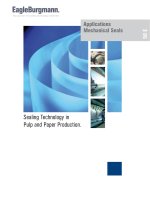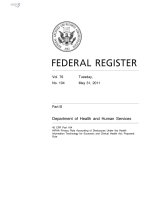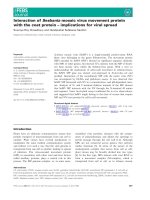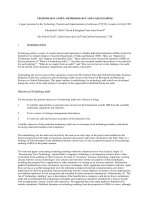CONSTRUCTION TECHNOLOGY ROY CHUDLEY AND ROGER GREENO
Bạn đang xem bản rút gọn của tài liệu. Xem và tải ngay bản đầy đủ của tài liệu tại đây (48.95 MB, 649 trang )
0131286420_COVER(Chudley) 4/17/07 2:00 PM Page 1
FOURTH EDITION
ROY CHUDLEY AND ROGER GREENO
The fourth edition of Construction Technology provides a comprehensive,
practical and authoritative introduction to the building process. Guidance on
building principles is accompanied with practice standards and, where
appropriate, interpretation of legislative requirements.
The content provides extensive coverage of low-rise domestic construction.
Also included are some elements of low-rise commercial and industrial
building techniques.
Key features
● references to current building regulations, British and European
Standards
● new chapter on Access and Facilities for the Disabled, as applied to
dwelling houses and flats
● updated information with regard to energy conservation issues relative to
new building work
● considers construction procedures from initial planning, through various
building and assembly techniques, to installation of services
● simple illustrations, defined notes with calculations and tables where
appropriate, complemented by a clearly defined layout throughout
Roy Chudley was formerly senior lecturer in building technology at Guildford
College of Technology. Roger Greeno is a consultant, examiner and
established author of many construction papers and
publications.
www.pearson-books.com
FOURTH
EDITION
CHUDLEY AND GREENO
Construction Technology is recommended for students in the initial years of
all building studies. This includes: GNVQ and AVCE in Construction and the
Built Environment; NVQs in Construction; BTEC Foundation Degrees; First
Diplomas, National Certificates and Diplomas in Construction. It is also an
essential reader for students on undergraduate courses in Construction
Management, Building Technology, Surveying, Architectural Technology,
Facilities Management and other building-related programs.
CONSTRUCTION
TECHNOLOGY
CONSTRUCTION
TECHNOLOGY
CT_A01.qxd 4/17/07 2:13 PM Page i
CONSTRUCTION TECHNOLOGY
CT_A01.qxd 4/17/07 2:13 PM Page ii
We work with leading authors to develop the strongest
educational materials in Building and Construction,
bringing cutting-edge thinking and best learning
practice to a global market.
Under a range of well-known imprints, including
Prentice Hall, we craft high quality print and electronic
publications which help readers to understand and
apply their content, whether studying or at work.
To find out more about the complete range of our
publishing, please visit us on the World Wide Web at:
www.pearsoned.co.uk
CT_A01.qxd 4/17/07 2:13 PM Page iii
CONSTRUCTION TECHNOLOGY
FOURTH EDITION
ROY CHUDLEY
MCIOB
Revised by
ROGER GREENO
BA (HONS), FCIOB, FIPHE, FRSA
CT_A01.qxd 4/17/07 2:13 PM Page iv
Pearson Education Limited
Edinburgh Gate
Harlow
Essex CM20 2JE
England
and Associated Companies throughout the world
Visit us on the World Wide Web at:
www.pearsoned.co.uk
© Pearson Education Limited 1973, 2005
The right of Roy Chudley to be identified as author of this work has been asserted by
him in accordance with the Copyright, Designs and Patents Act 1988.
All rights reserved; no part of this publication may be reproduced, stored in any retrieval
system, or transmitted in any form or by any means, electronic, mechanical, photocopying,
recording, or otherwise without either the prior written permission of the Publishers or a
licence permitting restricted copying in the United Kingdom issued by the Copyright
Licensing Agency Ltd, 90 Tottenham Court Road, London W1T 4LP.
First published (as Construction Technology) 1973 (Volume 1), 1974 (Volume 2)
Second edition 1987
Third edition (published as a single volume, with revisions by Roger Greeno) 1999
Reprinted 2002 (revised edition), 2003 (twice) (third edition update)
Fourth edition 2005
Reprinted 2006 (twice)
Reprinted 2007
British Library Cataloguing in Publication Data
A catalogue entry for this title is available from the British Library
Library of Congress Cataloging-in-Publication Data
Chudley, R.
Construction technology / Roy Chudley ; revised by Roger Greeno.—4th ed.
p. cm.
Includes bibliographical references and index.
ISBN 0-13-128642-0 (alk. paper)
1. Building. I. Greeno, Roger. II. Title
TH145.C49 2005
690—dc22
2005045899
ISBN: 978-0-13-128642-9
10
10
9 8 7 6
09 08 07
5
4
Set by 35 in 10/12pt Ehrhardt
Printed and bound in Malaysia
CT_A01.qxd 4/17/07 2:13 PM Page v
CONTENTS
Preface viii
Preface to third edition ix
Preface to second edition x
Acknowledgements xii
INTRODUCTION
1
PART 1 SITE AND TEMPORARY WORKS
1.1
1.2
1.3
1.4
1.5
Site works and setting out 15
Accommodation, storage and security
Subsoil drainage 31
Excavations and timbering 35
Scaffolding 41
PART 2 SUBSTRUCTURE
2.1
2.2
2.3
2.4
2.5
2.6
2.7
13
51
Trench and basement excavation 53
Foundations 59
Reinforced concrete foundations 66
Concrete 72
Retaining walls 80
Basements 93
Trees: effect on foundations 103
PART 3 SUPERSTRUCTURE
3.1 Stonework
3.2 Brickwork
111
122
109
22
CT_A01.qxd 4/17/07 2:13 PM Page vi
vi
Contents
3.3
3.4
3.5
3.6
3.7
3.8
3.9
3.10
Blockwork 142
Cavity walls 147
Openings in walls 153
Arches 162
Timber-framed housing 170
Timber: properties and grading
Timber deterioration 180
Steel-framed housing 186
PART 4 FLOORS
4.1
4.2
4.3
4.4
4.5
4.6
4.7
191
Solid concrete ground floor construction 193
Suspended concrete ground floor construction 198
Suspended timber floors 202
Raised access floors 219
Precast concrete floors 222
Hollow block and waffle floors 227
Lateral restraint and slenderness factors 232
PART 5 FUEL COMBUSTION
239
5.1 Fireplaces, chimneys and flues
5.2 Boiler flues 251
PART 6 ROOFS
6.1
6.2
6.3
6.4
6.5
6.6
174
241
259
Roofs: timber, flat and pitched 261
Roof tiling and slating 278
Asphalt flat roofs 290
Lead-covered flat roofs 295
Copper-covered flat roofs 299
Rooflights in pitched roofs 303
PART 7 INTERNAL FIXTURES AND FITTINGS
7.1
7.2
7.3
7.4
7.5
7.6
7.7
7.8
7.9
7.10
7.11
Doors, door frames and linings 313
Glass and glazing 329
Windows 339
Timber stairs 354
Simple reinforced concrete stairs 370
Simple precast concrete stairs 376
Partitions 378
Finishes: floor, wall and ceiling 383
Internal fixings and shelves 400
Ironmongery 405
Painting and decorating 413
311
CT_A01.qxd 4/17/07 2:13 PM Page vii
Contents vii
PART 8 INSULATION
8.1
8.2
8.3
8.4
417
Sound insulation 419
Thermal insulation 427
Thermal bridging 440
Draught-proofing and air permeability
443
PART 9 ACCESS AND FACILITIES FOR DISABLED PEOPLE:
DWELLING HOUSES AND FLATS
447
9.1
9.2
9.3
9.4
9.5
Accessibility 449
Circulation space: principal storey 452
WC facilities 454
Accessibility in flats, common stairs and lifts 456
Switches, sockets and general controls 458
PART 10 FRAMED BUILDINGS
10.1
10.2
10.3
10.4
10.5
10.6
10.7
Simple framed buildings 461
Reinforced concrete frames 463
Formwork 484
Precast concrete frames 499
Structural steelwork frames 505
Claddings 525
Steel roof trusses and coverings 535
PART 11 SERVICES
11.1
11.2
11.3
11.4
11.5
459
549
Domestic water supply 551
Sanitary fittings and pipework 564
Drainage 578
Domestic electrical installations 608
Domestic gas installations 616
Bibliography
Index 623
621
CT_A01.qxd 4/17/07 2:13 PM Page viii
PREFACE
Since the previous edition, reprint opportunities have permitted some amendments to
include new procedures resulting from legislative and practice changes. This edition
develops these further, with greater attention to information and detail. It also addresses
many more recent issues, especially aspects of the Building Regulations that now require
housing to be designed and built to more environmentally responsible and thermally
efficient standards. These include reducing fuel energy consumption of heating and hot
water equipment and the establishment of continuous insulation about the building
envelope. Reference is also provided for carbon emission assessment relative to the fuel
efficiency construction of dwellings.
Notwithstanding contemporary requirements, some well established building
practices and techniques described in previous editions are purposely retained. These
remain a valid reference to existing building stock.
Human rights issues are considered with regard to building designers and owners
responsibilities for providing accessibility for the disabled. The implications of the
Disability Discrimination Act and the associated Building Regulations for new dwellings
are outlined in a new chapter containing basic provisions.
As with previous editions the content is neither extensive nor prescriptive, space
would never permit inclusion of every possible means for constructing buildings.
However, the content is generally representative and details and explanations typical
of adopted procedures. Allowance should be made for regional traditions, material
resources and local standards.
The original concept of providing supplementary lecture support material for
students of construction is maintained. This book should be read in conjunction with
experiential learning in the work place or by observation. Further study of associated
legislation, practice guidance papers, product manufacturer’s literature and specialised
text is encouraged.
In conjunction with this edition’s companion volume, Advanced Construction
Technology, the reader should gain an appreciation of the subject material to support
progression through technical, academic and professional qualifications.
Roger Greeno
Guildford 2005
CT_A01.qxd 4/17/07 2:13 PM Page ix
PREFACE TO THIRD EDITION
Roy Chudley’s Construction Technology was first published in four volumes,
between 1973 and 1977. The material has since been continuously updated through
numerous reprints and full second editions in 1987. The books have gained a
world-wide readership, and their success – and their impact on construction
education – is a tribute to Roy Chudley’s experience in further and higher
education and his talents as a skilled technologist, illustrator and writer.
As a former colleague, it has been a privilege to once again work with Roy, on
this occasion revising his original work, and compiling the material into two books:
Construction Technology and Advanced Construction Technology. The content forms a
thorough study for all students of building, construction management, architecture,
surveying and the many other related disciplines within the diverse construction
profession.
The original presentation of comprehensive text matched by extensive
illustration is retained. Changes in legislation, such as the Building and
Construction Regulations, have been fully incorporated into the text; however,
as much of the original work as possible has been purposely retained as it contains
many relevant examples of existing construction. Additional material discusses the
new developments and concepts of contemporary practice.
The two new volumes are complementary, as many of the topics introduced here
are further developed in Advanced Construction Technology. Together the books
provide essential reading for all students aspiring to management, technologist and
professional qualifications. They should be read alongside the current local building
regulations and national standards, and where possible supplemented by direct
experience in the workplace.
Roger Greeno
Guildford 1998
CT_A01.qxd 4/17/07 2:13 PM Page x
PREFACE TO SECOND EDITION
Note: This book is a combined and updated edition of Volumes 1 and 2 of
Roy Chudley’s original Construction Technology.
Volume 1
In writing this book it is not my intention to present a comprehensive reference
book on elementary building technology, since there are many excellent textbooks
of this nature already in existence, which I urge all students to study.
My purpose, therefore, has been to prepare in concise note form, with ample
illustrations, the basic knowledge the student should acquire in the first year of
any building technology course of study.
To keep the book within a reasonable cost limit I have deliberately refrained
from describing in depth what has been detailed in the drawings.
Building technology is an extensive but not necessarily exact subject. There are
many ways of obtaining a satisfactory construction in building, but whichever
method is used they are all based upon the same basic principles and it is these
which are learnt in building technology.
The object of any building technology course is to give a good theoretical
background to what is essentially a practical subject. With the knowledge acquired
from such a course, coupled with observations of works in progress and any
practical experience gained, a problem should be able to be tackled with confidence
by the time the course of study has reached an advanced level.
Another aspect of a course of this nature is to give sufficient basic knowledge,
over the whole field of building activities, to enable the technologist to hold and
understand discussions with other related specialists.
Volume 2
The aim of this second volume is to provide a continuity of study with the contents
of Volume 1, which dealt mainly with domestic building. The second year of a
CT_A01.qxd 4/17/07 2:13 PM Page xi
Preface to second edition
xi
typical construction technology course will study further aspects of domestic
construction and introduce the student to framing techniques and materials. The
presentation is in the form of notes accompanied by ample illustrations with as
little repetition between notes and drawings as possible. It is also written with the
assumption that the reader has covered, understood and retained the technical
knowledge contained in a basic first-year course.
The depth of study presented in this volume is limited to the essential basic
knowledge required for a second-year construction technology course. The student
is therefore urged to consult all other possible sources of reference to obtain a full
and thorough understanding of the subject of construction technology.
Roy Chudley
CT_A01.qxd 4/17/07 2:13 PM Page xii
ACKNOWLEDGEMENTS
This book originated over 30 years ago as two separate publications. The two were
combined to create a single volume at the last edition. The continuing success and
popularity of this study resource can be attributed to contributions from numerous
sources, but unfortunately space does not permit credit to them all. Much can be
attributed to the observations and suggestions of some of my former colleagues,
professional associates and not least the positive response of so many of my past
students.
The book’s agreeable presentation of comprehensive text and simple illustration
is attributed to the late Colin Bassett as General Editor and of course, Roy Chudley
as founding author. I am especially grateful to Roy for his cooperation, trust
and permission to work on his original manuscript and hope that my attempts
to emulate his illustrative style bear some comparison with his original work.
Without the publisher, the book would not exist. The enthusiasm and support
of the staff at Pearson Education is appreciated; in particular that of Pauline Gillett
for her direction and patience throughout the preparation of this latest edition.
Roger Greeno
Guildford 2005
We are grateful to the Building Research Establishment and The Stationery
Office for permission to reproduce material from BRE Digests and various Acts,
Regulations and Statutory Instruments.
Extracts from British Standards are reproduced with the permission of BSI.
Complete copies can be obtained by post from BSI Customer Services, 389
Chiswick High Road, London, W4 4AL.
CT_A02.qxd 4/17/07 2:04 PM Page 1
INTRODUCTION
There are two general aspects to the construction of buildings:
n
n
conventional or traditional methods;
modern or industrialised methods.
Conventional or traditional methods are studied in the first two years of most
construction courses, with the intention of forming a sound knowledge base
before proceeding to studies of advanced techniques in the final years. There is,
nevertheless, an element of continuity and overlap between traditional and
contemporary, and both are frequently deployed on the same building, e.g.
traditional brick facing to a prefabricated steel-framed commercial building or
to a factory-made timber-framed house.
Initial studies of building construction concentrate on the smaller type of
structure, such as a domestic dwelling of one or two storeys built by labourintensive traditional methods. Generally it is more economic to construct this
type of building by these methods, unless large numbers of similar units are
required on the same site. In these circumstances, economies of scale may justify
factory-manufactured, prefabricated elements of structure. These industrialised
methods are usually a rationalised manufacturing process used to produce complete
elements, i.e. floors, walls, roof frames, etc. in modules or standardised dimensional
increments of 300 mm.
Very few building contractors in the UK and other developed countries employ
many staff directly. They are therefore relatively small companies when compared
with the capital value of the work they undertake. This is partly due to the variable
economic fortunes of the construction industry and the need for flexibility. Hence
most practical aspects of building are contracted out to specialist subcontracting
organisations, e.g. bricklayers, electricians, carpenters, in response to the main
contractor’s work load. The main contractor is effectively a building management
company, which could be engaged on a variety of work, including major serial
CT_A02.qxd 4/17/07 2:04 PM Page 2
2
Introduction
developments for the same client, maintenance work or aftercare programmes,
extensions to existing structures, or possibly just small one-off projects.
It is essential that all students of building have an awareness of the variable
methods of construction and application of materials in both traditional and
industrial practice, in order to adapt their career pattern to the diverse
expectations of the industry.
nnn
THE BUILDING TEAM
Building is essentially a team process in which each member has an important
role to play. Figure 1 shows the organisation structure of a typical team for a
large project, and the function of each member is outlined below.
n
n
n
n
n
n
n
n
n
n
Building owner The client; the person or organisation who finances and
commissions the work. They directly or indirectly employ all other personnel,
with particular responsibility for appointing the planning supervisor (usually
the architect) and nominating the principal contractor – see Construction
(Design and Management) Regulations 1994.
Architect Engaged by the building owner as agent to design, advise and
ensure that the project is kept within cost and complies with the design.
Clerk of works Employed on large contracts as the architect’s on-site
representative. The main function is to liaise between architect and main
contractor and to ensure that construction proceeds in accordance with the
design. They can offer advice, but directives must be through the architect.
Quantity surveyor Engaged to prepare cost evaluations and bills of
quantities, check tenders, prepare interim valuations, effect cost controls, and
advise the architect on the cost of variations.
Consulting engineers Engaged to advise and design on a variety of specialist
installations, e.g. structural, services, security. They are employed to develop
that particular aspect of the design within the cost and physical parameters of
the architect’s brief.
Principal or main contractor Employed by the client on the advice of
the architect, by nomination or competitive tendering. They are required to
administer the construction programme within the architect’s direction.
Contract’s manager or site agent On large projects, the main contractor’s
representative on site, with overall responsibility for ensuring that work proceeds
effectively and efficiently, i.e. in accordance with the design specification and
to time. Sometimes known as the general foreman, but this title is more
appropriate on small to modest-size contracts.
Surveyor Employed by the main contractor to check work progress and
assist the quantity surveyor in the preparation of interim valuations for stage
payments and final accounts. May also be required to measure work done for
bonus and subcontractor payments.
Estimator Prepares unit rates for the pricing of tenders, and carries out
pre-tender investigations into the cost aspects of the proposed contract.
Buyer Orders materials, obtains quotations for the supply of materials and
services.
CT_A02.qxd 4/17/07 2:04 PM Page 3
Introduction 3
Figure 1
n
n
n
n
n
n
The building team.
Accountant Prepares and submits accounts to clients and makes payments
to suppliers and subcontractors. May also have a costing department that
would allocate the labour and material costs to each contract to assist with the
preparation of accounts.
Administrator Organises the general clerical duties of the contractor’s office
for the preparation of contract documents and payment of salaries, subcontractors’
and suppliers’ invoices, insurances and all necessary correspondence.
Assistant contract manager Often a trainee, in the process of completing
professional examinations. Assists with the general responsibility for
administering site proceedings.
Nominated subcontractor Engaged by the client or architect for specialist
construction or installation work, e.g. lifts, air conditioning.
Domestic subcontractor Employed by the principal contractor to assist with
the general construction, e.g. ground workers, bricklayers.
Operatives The main workforce on-site; includes craftsmen, apprentices and
labourers.
The size of the building firm or the size of the contract will determine the
composition of the construction team. For medium-sized contracts some of the
above functions may be combined, e.g. that of the surveyor and estimator.
Furthermore, many design-and-build practices have been created by combining
the professional expertise of architect, builder and consultants. The objective is to
improve communications and create better working relationships to provide the
client with a more efficient and cost-effective service.
CT_A02.qxd 4/17/07 2:04 PM Page 4
4
Introduction
nnn
LEGISLATION
Many statutes made by Act of Parliament affect the construction of buildings and
associated work. The most significant are:
n
n
n
n
The Health and Safety at Work etc. Act 1974;
The Building Act 1984;
The Disability Discrimination Act 1995–2004;
The Town and Country Planning Act 1990.
THE HEALTH AND SAFETY AT WORK ETC. ACT 1974
This requires employers or their agents to implement an overall duty of care
through a safe system of working. This applies to people in the workplace
and others who could be affected by the work activity. The Act provides an
all-embracing standard supporting a framework of statutory instruments or
regulations administered by the Health and Safety Executive (HSE) through
specialist inspectors operating from local offices. The inspectorate has powers to
access premises, review a company’s safety records, issue improvement and
prohibition notices and, if necessary, effect prosecutions for non-compliance.
The following are the principal statutory instruments made under the Health
and Safety at Work etc. Act. They are legally binding on the client, architect and
builder:
The Construction (Design and Management) Regulations 1994
Establish mutual responsibility between client, designer and builder for
matters pertaining to the health and safety of site personnel throughout the
duration of a construction project. The client has prime responsibility for
appointment of a ‘project coordinator’ (usually the architect) and a ‘principal
contractor’ (usually the main contractor), and for ensuring that both are
adequately resourced, competent, and sufficiently informed of issues relating
to the development.
The project coordinator
Main responsibilities are to notify the HSE of the project details, to ensure
cooperation between designers, to coordinate the design with regard to
avoidance of undue risks, to prepare a pre-tender health and safety plan and
manual for the client’s use for advice, and to provide updates on health and
safety issues.
The principal contractor
Responsibilities are mainly to ensure site personnel comply with the health and
safety plan, to develop and update it throughout the duration of the work, and to
exclude from site unauthorised and uninsured persons.
CT_A02.qxd 4/17/07 2:04 PM Page 5
Introduction 5
The Construction (Health, Safety and Welfare) Regulations 1996
Establish objectives measured against assessment of risk, for the well-being
of personnel on a building site throughout the duration of work. The main areas
for assessment include: temporary timbering and other non-permanent support
facilities; safety barriers to excavations; air quality in the workplace; safe use of
doors, gates and other possible means of entrapment; defined traffic and pedestrian
routes; safe means of access to and egress from all workplaces, including special
considerations for scaffolds; and emergency lighting and power. Also, provision
must be made for welfare facilities, to include sanitation, hot and cold water supply,
first aid equipment/personnel, protective clothing, facilities to dry clothes, and
appropriate accommodation for meals. Implicit is good site management with
regard for organisation and planning.
Control of Substances Hazardous to Health Regulations 1994
Redress the balance in favour of health, since the introduction of the Health
and Safety at Work etc. Act has greater emphasis on safety. Manufacturing
companies are obliged to monitor and declare health risks of their products, and
building contractors must provide operatives with protective clothing and/or a
well-ventilated environment if required to use them. COSHH has promoted the
removal of harmful substances from materials, e.g. toxins, irritants and solvents,
but finding substitutes is not always possible. Timber preservatives, welding
fumes, dust from cement and plaster and insulating fibres are, as yet, a few of the
unavoidable harmful constituents in building materials. Where these are applied,
employers are obliged to monitor exposure levels, retain records, identify personnel
who could be at risk, and document the facilities provided for their protection.
The Manual Handling Operations Regulations 1992
Determine the employer’s responsibility to ensure that employees under their
control are not expected to undertake manual tasks that impose an undue risk of
injury. The client, or their agent the main contractor, must assess all manual
handling operations and reduce risk or injury or safety to the lowest practicable
level. This will be manifest in the provision of work systems, such as cranes and
hoists, that the employee is obliged to make full use of. Due regard must be
applied to:
n
n
n
n
tasks space availability, manipulating distance, body movement, excess pulling
and pushing and prolonged physical effort;
load unwieldy or bulky, eccentric, excessive, liability to shift, temperature and
sharpness of finish;
work environment surface finish (slippery, uneven or variable), lighting,
ventilation and temperature variation;
individual capacity unusual weight or dimension, health problems/
limitations, special training and provision of personal protective clothing.
CT_A02.qxd 4/17/07 2:04 PM Page 6
6
Introduction
THE BUILDING ACT 1984
This is a consolidating Act of primary legislation relating to building work. It
contains enabling powers and a means for the Office of the Deputy Prime Minister
to produce building regulations for the outline purpose of:
n
n
n
maintaining the health, well-being and convenience of people using and relating
to buildings;
promoting the comfort of building occupants, with due regard for the
conservation of fuel and efficient use of energy within the structure;
preventing the misuse of water, excessive consumption and contamination
of supply.
The building regulations or statutory instruments currently in place under the
Building Act are:
n
n
n
n
n
The Building Regulations applicable to England and Wales;
The Building (Approved Inspectors, etc.) Regulations;
The Building (Prescribed Fees) Regulations;
The Building (Inner London) Regulations;
The Building (Disabled People) Regulations.
The Building Regulations contain minimum performance standards expected of
contemporary buildings. They are supported by a series of Approved Documents
that are not mandatory, but which give practical guidance on compliance with
the requirements of the regulations. This guidance often incorporates British
Standard, Building Research Establishment, British Board of Agrément and
other authoritative references.
Control of the Building Regulations is vested in the local council authority.
However, a developer/builder can opt for private certification whereby the
developer and an approved inspector jointly serve an initial notice on the local
authority. This describes the proposed works, which the local authority can
reject (if they have justification) within 10 days of application. With this option,
the responsibility for inspecting plans, quality of work, site supervision and
certification of satisfactory completion rests with the approved inspector as
defined in The Building (Approved Inspectors, etc.) Regulations.
Building legislation is regionally divided throughout the UK, each area having its
own regulations:
n
n
n
n
The Building Regulations applicable to England and Wales;
The Building Standards (Scotland) Regulations;
The Building Regulations (Northern Ireland);
The Building (Inner London) Regulations.
There are also statutory provisions for the Channel Islands, Isle of Man and the
Republic of Ireland.
Approved Documents
The current Building Regulations came into effect in 2000. They are constantly
under review in response to new and changing technologies, public demands
CT_A02.qxd 4/17/07 2:04 PM Page 7
Introduction 7
and environmental directives. Therefore, since 2000 there have been numerous
amendments to the support series of Approved Documents. Those made under
the Regulations applicable to England and Wales are currently listed from A to T
(I, O and R omitted):
n
n
n
n
n
n
n
n
n
n
n
n
n
n
n
n
n
n
A – Structure;
B – Fire safety;
C – Site preparation and resistance to contaminants and moisture;
D – Toxic substances;
E – Resistance to the passage of sound;
F – Ventilation;
G – Hygiene;
H – Drainage and waste disposal;
J – Combustion appliances and fuel storage systems;
K – Protection from falling, collision and impact;
L1 – Conservation of fuel and power in dwellings;
L2 – Conservation of fuel and power in buildings other than dwellings;
M – Access to and use of buildings;
N – Glazing – safety in relation to impact, opening and cleaning;
P – Electrical safety;
Q – Electronics communications services;
S – Security systems;
Proposals only
T – Telecommunications systems.
}
There is another Approved Document made under Regulation 7 – Materials and
workmanship. This requires that any building subject to the Building Regulations
be carried out with proper materials and in a workmanlike manner.
The Approved Documents provide practical and technical guidance for
satisfying the Building Regulations. There is no obligation to adopt any of these,
provided the Building Regulations’ performance requirements are shown to be
satisfied in some other way. This may include European Technical Approvals,
British Board of Agrément certification, CE marking of products, and calculations
in accordance with acceptable structural standards for selection of components.
THE DISABILITY DISCRIMINATION ACT 1995 –2004
This Act was introduced in three stages between 1995 and 2004. It is designed to
assist and benefit an estimated 8 million UK residents who suffer some sort of
disability. In principle, the Act requires that all new, adapted and refurbished
buildings be constructed with unobstructed access and facilities that can be used by
wheelchair occupants. This requirement extends to service providers and owners of
public buildings.
Building Regulations Part M – 2004
Part M and Approved Document M: Access to and use of buildings has been revised
in support of the Act. The Regulations provide design and practical guidance
for disabled user convenience in new and refurbished buildings. All new homes
CT_A02.qxd 4/17/07 2:04 PM Page 8
8
Introduction
(houses and flats) are required to be constructed with sufficient accessibility and
use of facilities for disabled people. The objective is to allow disabled and elderly
people greater freedom of use and independence in their own homes for a longer
period of time. The Regulations also allow for internal and external accessibility for
wheelchair users in buildings other than dwellings. Movement in and around all
buildings is to enable the disabled the same means of access that ambulant people
enjoy when visiting friends, relatives, shops, entertainments and other conveniences
without being impeded.
The main features of the Approved Document are as follows:
n
n
n
n
n
n
n
n
n
Access approach from car parking area to the main entrance of a building to be
level or ramped.
Main entrance threshold to be level, not stepped.
Main entrance door wide enough for a wheelchair.
WC facilities at ground or entrance floor.
WC compartment with sufficient manoeuvrability space for a wheelchair user.
WC facilities at accessible levels for ambulant and disabled people.
Switches for lighting, power sockets, heating control etc. at convenient heights
above floor level.
In flats, lifts provided to access all floors.
In houses, the structure about a stair to be strong enough to support a stair lift.
BS 8300: Design of buildings and their approaches to meet the needs of
disabled people. Code of Practice
This British Standard complements the Building Regulations and the Disability
Discrimination Act. It was produced from government-commissioned research into
the ergonomics of modern buildings. The Standard presents the built environment
from the perspective of the disabled user, with particular regard to residential
buildings as occupier and visitor, and public buildings as spectator, customer and
employee. The Standard also considers the disabled as participants in sports events,
conferences and performances.
THE TOWN AND COUNTRY PLANNING ACT 1990
This Act establishes the procedures for development of land and construction of
buildings. It is administered through the hierarchy of government, regional and
local offices:
n
n
n
central government;
county planning departments;
local borough planning departments.
Central government is represented by the Office of the Deputy Prime Minister
(ODPM). They issue departmental circulars or policy planning guidance (PPG)
to county planning departments. PPGs contain directives for implementing
government policy for overall development on a large scale, e.g. Thames Gateway.
CT_A02.qxd 4/17/07 2:04 PM Page 9
Introduction 9
Included are objectives and a perspective for housing needs, communications
systems, transport, social facilities, green belts, redevelopment, retail and
commercial plans.
County planning departments formulate development policy within the
framework determined by the ODPM. This is known as the Structure Plan.
Structure plans are prepared with regard for ‘brownfield’ sites (usually redundant
industrial buildings) and ‘greenfield’ sites (undeveloped land), in accordance
with anticipated future needs. These include social and economic demands for
housing, and commercial, social and recreational facilities within a viable
communications and transport infrastructure. Structure plans are subject to public
consultation, and once established they normally remain in place for 15 years.
Local planning departments or local authorities establish a Local Plan for
their borough or region. This is produced within the framework of the Structure
Plan with regard for an economic, social and practical balance of facilities for the
various communities under their administration. To maintain a fair and equitable
interest, local plans are subject to public and ODPM consultation. Local authorities
are also responsible for processing applications for development in their area.
Applications range from a nominal addition to an existing building to substantial
estate development. Procedures for seeking planning consent vary depending on
the scale of construction. All require the deposit of area and site plans, building
elevations, forms declaring ownership or nature of interest in the proposal, and
a fee for administration. If an application is refused, the applicant has a right of
appeal to the ODPM.
nn n
BRITISH STANDARDS
These function as support documents to building design and practice. Many are
endorsed by the Building Regulations and provide recommendations for minimum
material and practice specifications. They are published in four possible formats:
n
n
n
n
Codes of practice (BS Code of practice for . . . ) These are guides to good
practice in particular areas of construction activity, e.g. scaffolding and structural
steelwork.
Standard specifications (BS) These are specifications appropriate to
materials and components such as bricks and windows. Products complying may
be endorsed with the Institution’s kitemark.
Draft for development (DD) These are issued instead of a Code of practice
or Standard specification where there is insufficient data or information to make
a firm or positive recommendation. They have a maximum life of five years,
during which time sufficient data may be accumulated to upgrade the draft to a
Standard specification.
Published document (PD) These are publications that are difficult to locate
in any of the preceding categories.
Codes of practice and standard specifications are compiled by specialist committees
of professional interest in the particular subject. It must be remembered that these
codes and specifications are only recommendations. However, many are used in the
CT_A02.qxd 4/17/07 2:04 PM Page 10
10
Introduction
Building Regulations, Approved Documents as a minimum acceptable standard for
specific applications. Copies of the codes and specifications can be obtained from
the British Standards Institution (Customer Services), 389 Chiswick High Road,
London, W4 4AL, or online from
nnn
AGRÉMENT CERTIFICATES
These are administered by the British Board of Agrément, Bucknalls Lane,
Garston, Watford WD25 9DA. Their purpose is to establish the quality and
suitability of new products and innovations not covered by established performance
documents such as British (BSI) or European Standards (CEN). The Board
assesses, examines and tests materials and products with the aid of the Building
Research Establishment and other research centres, to produce reports. These
reports are known by the acronym MOATS (Methods Of Assessment and Test).
Products satisfying critical examination relative to their declared performance are
issued with an Agrément Certificate.
nnn
INTERNATIONAL STANDARDS
Many British Standards have been harmonised with the dimensional and material
specifications of European continental products and vice versa. For example, BS
EN 196-2: 1995: Chemical analysis of cement has replaced BS 4550: Part 2: 1970:
Methods of testing cement; chemical tests. European standards are administered by the
Comité Européen de Normalisation (CEN), which incorporates bodies such as the
British Standards Institution (BSI) from member states.
The International Standards Organisation also produces documents compatible
with British Standards. These are prefixed ISO: for example, BS EN ISO 9004:
Quality management systems complements BS 5750-8: Quality systems.
nnn
METRICATION
Since the building industry adopted the metric system of measurement during
the early 1970s there has been a great deal of modification and rationalisation as
designers and manufacturers have adapted themselves to the new units.
Most notable has been product developments coordinated about the preferred
dimension of 300 mm. The second preference is 100 mm, with subdivisions
of 50 mm and 25 mm as third and fourth preferences respectively. Many
manufacturers now base their products on the 100 mm module, and coordinate
their components within a three-dimensional framework of 100 mm cubes. This
provides product compatibility and harmonisation with international markets that
are also metric and dimensionally coordinated. Kitchen fitments provide a good
example of successful development, with unit depths of 600 mm and widths in
300, 600, 1200 mm and so on. Less successful has been the move to metric bricks
in lengths of 200 or 300 mm × 100 mm wide × 75 mm high. They are just not
compatible with existing buildings, and bricklayers have found them less suited
to the hand.
CT_A02.qxd 4/17/07 2:04 PM Page 11
Introduction 11
Although the metric system is now well established, it should be remembered
that a large proportion of the nation’s buildings were designed and constructed
using imperial units of measurement, which are incongruous with their metric
replacements. Many building materials and components will continue to be
produced in imperial dimensions for convenience, maintenance, replacement
and/or refurbishment, and where appropriate some manufacturers provide
imperial–metric adaptors, e.g. plumbing fittings. The prohibitive capital cost
of replacing manufacturing plant such as brick presses and timber converters
will preserve traditional imperial dimensions for some time.
CT_A02.qxd 4/17/07 2:04 PM Page 12









